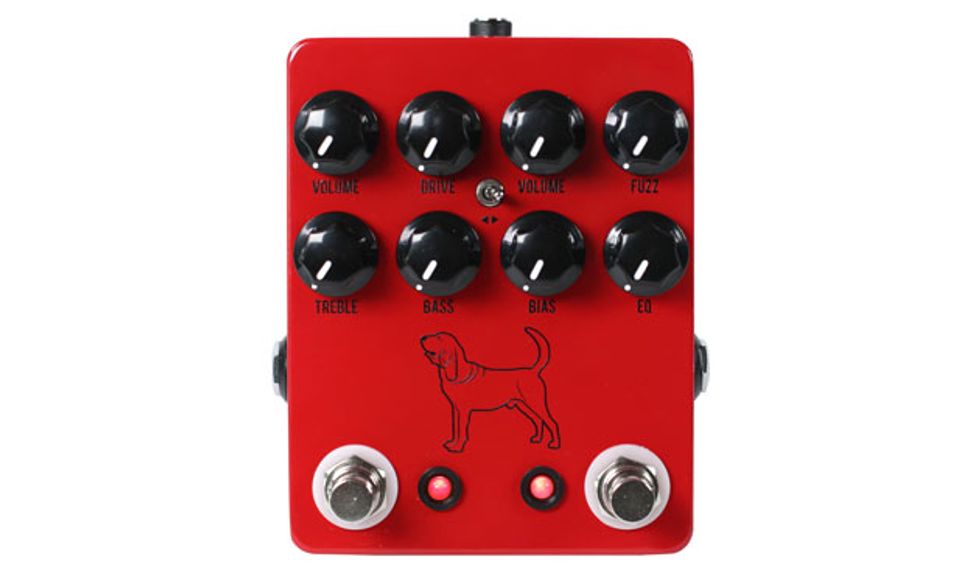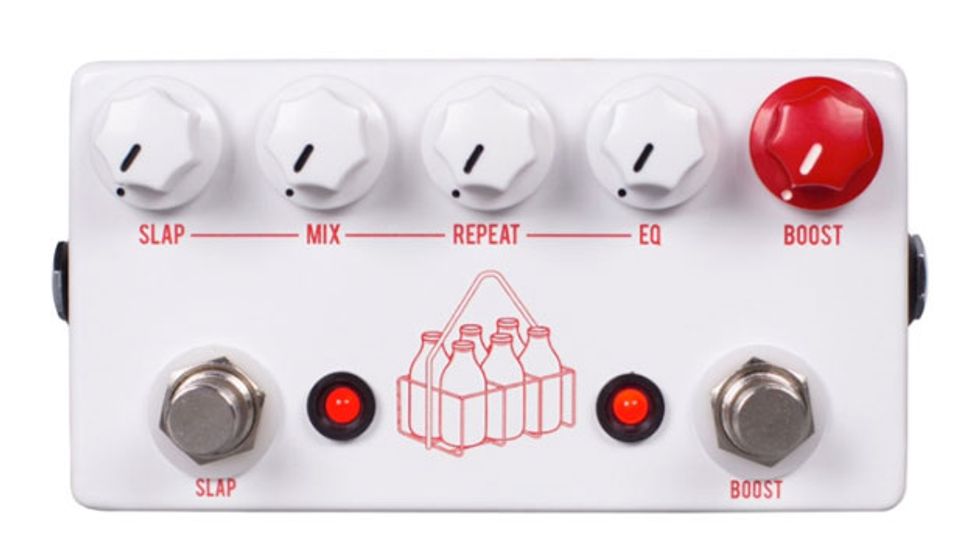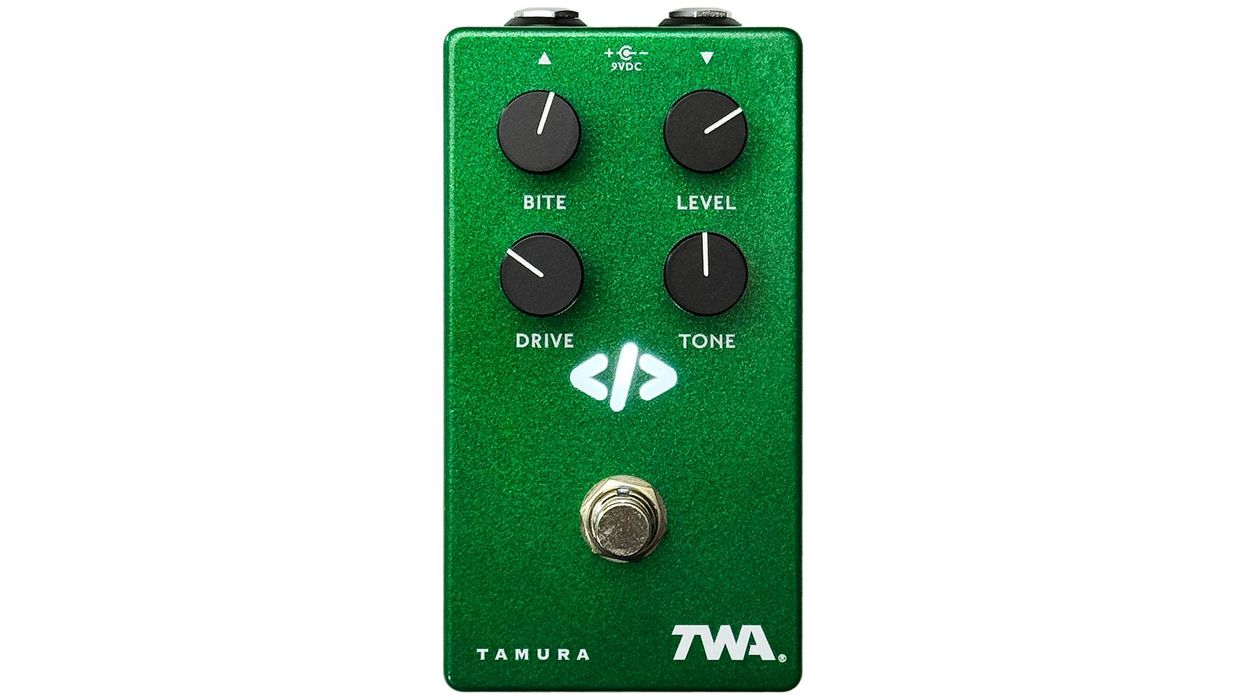Kansas City, MO (April 24, 2017) -- Shipping to Dealers worldwide April 24th, The Milkman is a collaborative idea between Josh Scott of JHS Pedals and Tim Marcus of Milkman Sound. The concept is simple; a single pedal that offers up an echo/slap delay and a boost that can be used as an always-on enhancer or as an overdrive for small wattage amplifiers. Josh designed the circuit in late 2016 and here we are, a small footprint, easy to use boost/echo 2-in-1 that fits into any style players rig with ease.
The right side of the pedal is the boost side. This boost is a discreet amplifier-based circuit with tons of power and character. Simply set it low at unity gain for an always-on enhancer that fattens up and clarifies your tone, or turn more clockwise to push your tube amplifier into sweet natural overdrive. The left side of the pedal is the echo/slap delay circuit. This circuit is designed to emulate a hybrid of tape echo and analog BBD delay, and cover the tonal grounds between both. The controls are simple and it sounds good in every setting. The “Slap” knob is the amount of delay time. As you turn the knob up, you will get longer delay times. Keep in mind, this pedal is designed for shorter vintage slap-back delay times. The “Mix” knob is the effect level. Full counter clockwise is all dry and full clockwise is full wet/effect. The “Repeat” knob controls how many echoes or repeats you get. The minimum is one and maximum is around 4.5 repeats. The "Repeat" knob lets you fine-tune how many delays you will get. Lastly is the “EQ” knob. This control only affects the repeat delay signal so that you can perfectly adjust the brightness or darkness of your echo. When fully counter clockwise the repeats are at their darkest much like an old BBD analog delay. When fully clockwise the repeats are the brightest they will be with more grit, this is much like a classic tape delay machine. The longest echo/delay time on the Milkman is about 240ms.The footswitching is our typical 2-in-1 arrangement where either effect can be used separately or together. The footswitch on the left controls the delay and the footswitch on the right will turn the boost on/off.
The Milkman uses standard 9v DC Negative power only.
The Milkman by JHS Pedals will retail at $179.
Shipping to Dealers worldwide April 24th, The Calhoun V2 is a collaborative signature pedal for legendary guitarist, writer, and producer Mike Campbell. Mike is most known for his role in Tom Petty and The Heartbreakers, but he has worked closely with such artists as Don Henley, Bob Dylan, Stevie Nicks, George Harrison, Jackson Browne, Brian Setzer, Johnny Cash, Fleetwood Mac and The Wallflowers to name a few. He also is a founding member of Mudcrutch and has a side project called the Dirty Knobs. When the opportunity to create his only signature pedal came to us, we were honored, to say the least. Let's go over what the Calhoun V2 has to offer.
The Calhoun V2 is a 2-in-1 overdrive/fuzz pedal that is designed around Mike's specific desires for live and studio performance. The left side of the Calhoun is the drive portion of the pedal with Volume, Drive, Treble, and Bass controls. The Volume control is a master level control allowing you to set the maximum or minimum volume of the pedal. The Drive control adjusts how much dirt/distortion you are allowing in the circuit. The Treble and Bass controls adjust the EQ of the pedal, allowing you to darken and brighten the frequencies as needed. The right side of the Calhoun V2 is the fuzz portion, with Volume, Fuzz, Bias, and EQ controls. The Volume control acts as the same master volume control as the left side. The Fuzz control adjusts the intensity of the fuzz sound. The Bias control adjusts the voltage to the circuit allowing more powerful tones that bloom with more headroom or weaker and more saturated tones. The EQ control lets you set the range of tone from dark to bright as you wish. The toggle switch allows you to choose the order of the two effects when stacked (both on at the same time). The effect that the toggle is pointed at is first in series; this lets you stack the effects in whichever way you desire to achieve different textures of stacked tones.The power jack is a standard 9v DC operation. The right 1/4" jack is the input jack where you plug in your instrument. The left 1/4" jack is the output jack where you go out into your amplifier.
Last but not least you may have noticed from the first look demo we shared with you from the Heartbreakers rehearsal space in LA: Calhoun is a real dog. Not only does Mike love dogs but he and his wife are very involved with an amazing organization called The Tazzy Fund. Mike has requested that every penny of his profits from each unit go directly to The Tazzy Fund Animal Rescue to help fund its needs and mission. Check out their info here: https://www.tazzyfund.comThe Calhoun is the perfect pedal for the player who wants straightforward, no frills and easy to use dirt tones in a single package. It covers everything you need for rock and blues tones with ease. Be a part of rock & roll history and join Mike by adding the Calhoun V2 to your rig!
This pedal measures 3.68” x 4.67” x x 1.547” and operates on standard DC Negative 9V.
The Calhoun by JHS Pedals will retail at $315.
For more information:
JHS Pedals




























